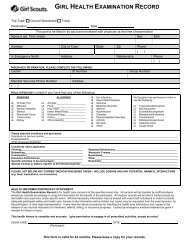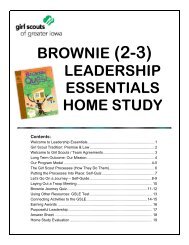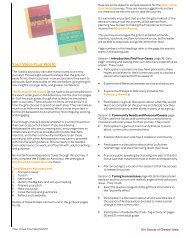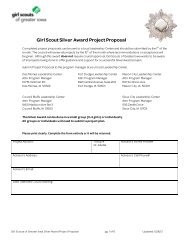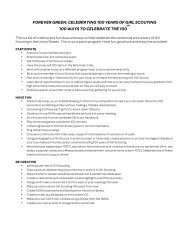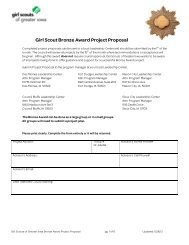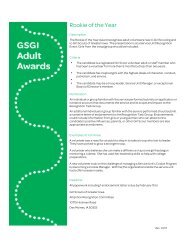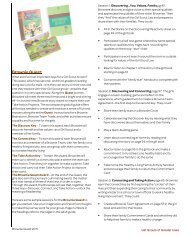The Girl Scout Bronze Award - Girl Scouts of Greater Iowa
The Girl Scout Bronze Award - Girl Scouts of Greater Iowa
The Girl Scout Bronze Award - Girl Scouts of Greater Iowa
Create successful ePaper yourself
Turn your PDF publications into a flip-book with our unique Google optimized e-Paper software.
Guidelines for <strong>Girl</strong> <strong>Scout</strong> Juniors <br />
<strong>Girl</strong> Guidelines<br />
<strong>The</strong> <strong>Girl</strong> <strong>Scout</strong> <strong>Bronze</strong> <strong>Award</strong><br />
Welcome to the <strong>Girl</strong> <strong>Scout</strong> <strong>Bronze</strong> <strong>Award</strong>, a leadership adventure for you and more<br />
than half a million other <strong>Girl</strong> <strong>Scout</strong> Juniors across the country and around the world.<br />
Imagine what you can accomplish when you team up with others and use your special<br />
skills and interests to take action and make a difference in the world!<br />
As you can tell, this <strong>Girl</strong> <strong>Scout</strong> <strong>Bronze</strong> <strong>Award</strong> adventure is big—in fact, this award is<br />
the highest honor a <strong>Girl</strong> <strong>Scout</strong> Junior can achieve. As you and your team plan and<br />
complete your project, you’ll develop more confidence, meet new people, and have the<br />
kind <strong>of</strong> fun that happens when you work with other <strong>Girl</strong> <strong>Scout</strong>s to make a difference.<br />
Here are the steps you’ll take to earn your <strong>Girl</strong> <strong>Scout</strong> <strong>Bronze</strong> <strong>Award</strong>:<br />
1. Go on a <strong>Girl</strong> <strong>Scout</strong> Junior journey.<br />
2. Build your <strong>Girl</strong> <strong>Scout</strong> Junior team.<br />
3. Explore your community.<br />
4. Choose your <strong>Girl</strong> <strong>Scout</strong> <strong>Bronze</strong> <strong>Award</strong> project.<br />
5. Make a plan.<br />
6. Put your plan in motion.<br />
7. Spread the word.<br />
When you go for the <strong>Bronze</strong> <strong>Award</strong>, you represent what <strong>Girl</strong> <strong>Scout</strong>s can achieve in their<br />
communities. And, <strong>of</strong> course, you want to do that in a way that’s fun for you—and for<br />
everyone else involved, too! Earning the <strong>Girl</strong> <strong>Scout</strong> <strong>Bronze</strong> <strong>Award</strong> involves the time to<br />
complete a journey, and then a suggested minimum <strong>of</strong> 20 hours building your team,<br />
exploring your community, choosing your project, planning it, putting your plan in<br />
motion, and spreading the word about your project. <strong>The</strong> suggested hours help you<br />
think about your commitment to doing your very best with each step. That's different<br />
for every <strong>Girl</strong> <strong>Scout</strong>, so these hours aren't a rule, just a friendly reminder. You’re a <strong>Girl</strong><br />
<strong>Scout</strong>, which means you will earn your award with courage, confidence, and character<br />
and make a difference in the world around you!<br />
Step 1: Go on a <strong>Girl</strong> <strong>Scout</strong> Junior Journey<br />
<strong>The</strong> first requirement for earning the <strong>Girl</strong> <strong>Scout</strong> <strong>Bronze</strong> <strong>Award</strong> is completing a <strong>Girl</strong><br />
<strong>Scout</strong> journey. If you haven’t done one yet, now’s the time! You can choose either It’s<br />
1
<strong>Girl</strong> Guidelines<br />
<strong>The</strong> <strong>Girl</strong> <strong>Scout</strong> <strong>Bronze</strong> <strong>Award</strong><br />
Your World—Change It! or It’s Your Planet—Love It! Most girls say they spend three or<br />
four months on a journey, but that’s not a rule: Take all the time you need.<br />
When you’ve finished your journey, you’ll have earned three special leadership awards.<br />
Set aside some time to think about all you learned and accomplished. Here are some<br />
questions you might want to think about:<br />
• How did you use the values <strong>of</strong> the <strong>Girl</strong> <strong>Scout</strong> Law during your <strong>Girl</strong> <strong>Scout</strong> Junior<br />
journey?<br />
• What did you discover about yourself?<br />
• Who did you connect with?<br />
• How did you take action, and what did you learn?<br />
<strong>The</strong>n take your next step: Creating your very own <strong>Girl</strong> <strong>Scout</strong> <strong>Bronze</strong> <strong>Award</strong> adventure.<br />
Step 2: Build Your <strong>Girl</strong> <strong>Scout</strong> Junior Team<br />
What’s a <strong>Girl</strong> <strong>Scout</strong> Junior team? That’s you and other <strong>Girl</strong> <strong>Scout</strong> Juniors who are on<br />
this adventure together, plus your troop/group volunteer. If there are no other <strong>Girl</strong><br />
<strong>Scout</strong> Juniors in your neighborhood, seek out some friends your age—they can even<br />
join <strong>Girl</strong> <strong>Scout</strong>s and earn the award with you! More girls equal more friends, more<br />
ideas, and more ways to make a difference.<br />
After you’ve built your team, hold a meeting and spend some time getting to know<br />
each other. After all, making new friends is one <strong>of</strong> the fun parts <strong>of</strong> being a <strong>Girl</strong> <strong>Scout</strong>!<br />
You could start by playing a game, perhaps one that you played on your <strong>Girl</strong> <strong>Scout</strong><br />
Junior journey, at summer camp, or at school. Of course, if you’re working with other<br />
girls in your troop, you already know each other quite well. Even so, you probably<br />
don’t know everything about each other. You might be surprised at what you learn<br />
about girls you’ve known since kindergarten!<br />
It’s also a good idea to think about what you each enjoy doing the most. Soon, your<br />
team will explore and choose an idea for a Take Action project. Keep handy your<br />
team’s list <strong>of</strong> what each member loves to do; it will help you in a few ways:<br />
• You’ll know the special talents each <strong>of</strong> you can bring to the project you choose.<br />
2
<strong>Girl</strong> Guidelines<br />
<strong>The</strong> <strong>Girl</strong> <strong>Scout</strong> <strong>Bronze</strong> <strong>Award</strong><br />
• You’ll learn more about each team member so that you can be a great Take<br />
Action team.<br />
• You may even touch on something that becomes the beginning <strong>of</strong> an idea for a<br />
Take Action project!<br />
Here are some questions to help you pinpoint your interests:<br />
• Do you read everything you can get your hands on—even the back <strong>of</strong> the cereal<br />
box?<br />
• Do you love playing with your pets?<br />
• Do you spend hours painting, singing, or dancing?<br />
Are you always in motion—riding your bike, surfing, or playing soccer?<br />
Really spend some time thinking about all the things you love to do, from conducting<br />
science experiments to taking care <strong>of</strong> younger kids to whipping up fruit smoothies for<br />
your friends!<br />
At the end <strong>of</strong> your first meeting, talk about what everyone thinks the group should do<br />
to be a great team, like “listen to others without interrupting” or “help out at each<br />
meeting.” Write the suggestions on a large piece <strong>of</strong> paper and post it on the wall<br />
whenever you have team meetings.<br />
Step 3: Explore Your Community<br />
<strong>The</strong>re are many ways to make a difference, so what’s the best project idea for your<br />
team? One that you come up with yourselves, <strong>of</strong> course! How can you do that? <strong>The</strong><br />
first step is to take a close look at what’s going on right around you. Maybe you have<br />
ideas from when you did your <strong>Girl</strong> <strong>Scout</strong> Junior journey—was there a project you didn’t<br />
have time for that you could work on now?<br />
Start by exploring your community: your block, your neighborhood, or your school. As<br />
you walk or bike around town, keep your eyes open for ways you can make a positive<br />
change. As you take a bus to school or ride in the car with your parents, look for<br />
problems that should be fixed. (You might even spot something that could make<br />
everyone’s daily ride on the school bus a little bit better!) As you spend the day in<br />
school, take note <strong>of</strong> how things could be improved.<br />
3
<strong>Girl</strong> Guidelines<br />
<strong>The</strong> <strong>Girl</strong> <strong>Scout</strong> <strong>Bronze</strong> <strong>Award</strong><br />
Here are a few tips:<br />
• In addition to observing on your own, you can make this a team activity. Get<br />
together as a group to walk around your school or your block, talking about<br />
what you see.<br />
• Keep a notebook handy to jot down what you see, plus any ideas about possible<br />
projects.<br />
• Keep an open mind as you look around! Sometimes, ideas come from seeing a<br />
problem that needs to be fixed, such as people wasting paper in your school.<br />
Sometimes they come from seeing a chance for improvement, such as painting<br />
a wall mural that celebrates your neighborhood’s history.<br />
• Feeling stuck? Think about something that would make your life better; chances<br />
are, other people have that same idea! For example, maybe you’d like to<br />
exercise more because you know it will make you healthier, but you don’t know<br />
how to get started. Other people might feel the same way. How about creating a<br />
“Let’s Move It!” club that meets once a week after school? You can jump rope,<br />
play hopscotch, run races—anything that keeps you active!<br />
<strong>The</strong> following Observation List is a great way to keep track <strong>of</strong> your observations. Write<br />
your observations in the left-hand column, and then write your possible solutions in<br />
the right-hand column. A few examples are listed to get you started. After you have<br />
filled in your chart, circle the three ideas that matter most to you. But don’t worry if<br />
you don’t have many “Maybe We Could” ideas yet. <strong>The</strong> important thing is to identify<br />
what you care about and want to take action on.<br />
4
<strong>Girl</strong> Guidelines<br />
<strong>The</strong> <strong>Girl</strong> <strong>Scout</strong> <strong>Bronze</strong> <strong>Award</strong><br />
Observation List<br />
Observation<br />
What do you see and hear around you? Here are<br />
ideas for what to look out for, what you see and<br />
hear around you.<br />
Our <strong>Girl</strong> <strong>Scout</strong> meeting space isn’t very<br />
“green,” and we’d also like to make the<br />
space more fun for younger <strong>Girl</strong> <strong>Scout</strong>s.<br />
A recent flood damaged more than 100<br />
homes in town.<br />
Maybe We Could . . .<br />
Possible project ideas to make a difference.<br />
Add fun decorations that are also<br />
“green,” and figure out how much<br />
energy we use during our meetings.<br />
Find out how people prepare for floods;<br />
think <strong>of</strong> ways to share what we learned.<br />
Add your own . . . what else do you<br />
observe in the course <strong>of</strong> a day in your<br />
life?<br />
Here are a couple <strong>of</strong> examples to show how an observation led to a Take Action project<br />
(steps 4–6 will give you more tips about how to do the same thing yourself):<br />
Example #1<br />
Lucia and her Junior team were going after their <strong>Girl</strong> <strong>Scout</strong> <strong>Bronze</strong> <strong>Award</strong>, so they all<br />
agreed to be extra observant <strong>of</strong> everything going on around them. Here’s what Lucia<br />
observed and how it turned into their Take Action project:<br />
5
<strong>Girl</strong> Guidelines<br />
<strong>The</strong> <strong>Girl</strong> <strong>Scout</strong> <strong>Bronze</strong> <strong>Award</strong><br />
1. First, Lucia noticed that cars whizzed down the street near their school. This<br />
happened a few days in a row—it seemed to be a real problem.<br />
2. <strong>The</strong>n, she heard on the news that in the last year there had actually been<br />
several accidents in that same area.<br />
3. <strong>The</strong> Junior team asked their troop/group volunteer to help them find out how<br />
people in their community decided where stop signs were needed.<br />
4. After a visit to both the police station and a local government <strong>of</strong>fice, here’s what<br />
the Juniors did: <strong>The</strong>y wrote a petition, asking for a new stop sign on the road<br />
near their school, got local residents to sign it, and then presented it to their<br />
local government <strong>of</strong>ficials. Result: A new stop sign, slower traffic, fewer<br />
accidents, and safer kids! Plus, a stop sign is a permanent solution!<br />
Example #2<br />
Tanya and her Junior team also decided to be extra observant for a week or two. When<br />
they got together to share what they observed, Tanya asked her friends, “Have you<br />
ever noticed how hard it is for older people or people with disabilities to get around the<br />
grocery store?” <strong>The</strong> team agreed that this was a problem that no one seemed to be<br />
addressing. It seemed like a good challenge for their team! Here’s what they did:<br />
1. First, they decided to visit the store together and just watch as people shopped.<br />
This convinced them that some people could use a little extra help.<br />
2. <strong>The</strong>n they met as a team and brainstormed how they could help and how they<br />
could explain their project idea to the store manager.<br />
3. Next, they met with the store manager. Here’s what happened next: <strong>The</strong> girls<br />
got permission to team up during the peak holiday season and <strong>of</strong>fer their<br />
assistance to shoppers. Sometimes they would take a person’s grocery list and<br />
go up and down the aisles to get products. Other times, they would walk around<br />
the store with people and help them fill their baskets. In both cases, they helped<br />
people get through the checkout line and out to their cars. To keep this project<br />
going, they wrote a tip sheet about how other youth and volunteer groups can<br />
do the same thing.<br />
6
<strong>Girl</strong> Guidelines<br />
<strong>The</strong> <strong>Girl</strong> <strong>Scout</strong> <strong>Bronze</strong> <strong>Award</strong><br />
Step 4: Choose Your <strong>Girl</strong> <strong>Scout</strong> <strong>Bronze</strong> <strong>Award</strong> Project<br />
Now that you’ve observed what’s going on in your community, here are some steps to<br />
take in order to choose your <strong>Girl</strong> <strong>Scout</strong> <strong>Bronze</strong> <strong>Award</strong> project:<br />
1. Meet with your team to share what you’ve seen. You might find that many <strong>of</strong><br />
you noted the same problems or ideas. Your troop/group volunteer can help you<br />
make a list <strong>of</strong> the top observations from all the girls on the team.<br />
2. Brainstorm ideas about where you can make a difference, based on what you’ve<br />
seen. Once you have a list that everyone likes, work together to choose the top<br />
three topics that interest everyone the most.<br />
3. Now that you’ve come up with your top ideas, you need to get more information<br />
so you can understand how you can best help make a difference. Here are a few<br />
tips to get you started on your fact-finding mission:<br />
• To really understand a problem, you need to get information from many<br />
places—talking to different people, reading newspaper and magazine<br />
articles, and doing research at the library and on the Internet.<br />
(Remember to first take the <strong>Girl</strong> <strong>Scout</strong> Internet Safety Pledge at<br />
www.girlscouts.org/internet_safety_pledge.asp.) This may seem like a lot<br />
<strong>of</strong> work, but don’t worry, you can share the jobs—after all, that’s what<br />
teams are for! One person can go online to read newspaper articles,<br />
someone else can volunteer to check out books from the library, and so<br />
on.<br />
• Brainstorm with your team and your troop/group volunteer about where<br />
to get more information. You can also visit the library and talk to the<br />
librarian. That’s a great way to get suggestions <strong>of</strong> who to talk to—and get<br />
ideas for a great project.<br />
• It can be hard to talk to adults, especially if you don’t already know them!<br />
Talk about your ideas with your teachers and neighbors first—you’ll start<br />
to feel more confident about asking questions <strong>of</strong> other adults. And<br />
remember that you’ll be with other members <strong>of</strong> your team as you talk to<br />
adults, and that always helps!<br />
• Take notes about what you learn as you do your research. A blank Project<br />
Idea Chart is included at the end <strong>of</strong> this guide for you to write down who<br />
7
<strong>Girl</strong> Guidelines<br />
<strong>The</strong> <strong>Girl</strong> <strong>Scout</strong> <strong>Bronze</strong> <strong>Award</strong><br />
you talked to, what you learned, and your ideas for the kind <strong>of</strong> project<br />
you can create. Here are a few project ideas—take a look, and then add<br />
your own in the blank Project Idea Chart at the end <strong>of</strong> this guide!<br />
Project Idea Chart<br />
Observations<br />
Our <strong>Girl</strong> <strong>Scout</strong><br />
meeting space isn’t<br />
very “green,” and<br />
we’d also like to<br />
make the space<br />
more fun for<br />
younger <strong>Girl</strong><br />
<strong>Scout</strong>s.<br />
A recent flood<br />
damaged more<br />
than 100 homes in<br />
town.<br />
Who We Talked<br />
To<br />
Other <strong>Girl</strong> <strong>Scout</strong>s<br />
and their families,<br />
including younger<br />
<strong>Girl</strong> <strong>Scout</strong>s<br />
<strong>The</strong> owner <strong>of</strong> a<br />
local hardware<br />
store<br />
An emergency<br />
medical technician<br />
(EMT)<br />
A firefighter<br />
A Red Cross<br />
<strong>of</strong>ficial<br />
Families who had<br />
damaged homes<br />
What We<br />
Learned<br />
We can turn<br />
down the air<br />
conditioner and<br />
add plants to<br />
make our space<br />
“greener.”<br />
Younger <strong>Girl</strong><br />
<strong>Scout</strong>s would like<br />
to help decorate<br />
our space.<br />
Everyone’s<br />
interested in<br />
seeing what girls<br />
in other<br />
countries look<br />
like.<br />
Many families<br />
aren’t prepared<br />
for disasters<br />
such as floods,<br />
hurricanes, and<br />
tornados.<br />
Everyone should<br />
be aware <strong>of</strong> the<br />
steps to take in<br />
order to stay<br />
safe.<br />
Maybe We Could<br />
Have a family<br />
workday when<br />
everyone can come<br />
together to clean and<br />
paint.<br />
Post photos <strong>of</strong> <strong>Girl</strong><br />
Guides and <strong>Girl</strong><br />
<strong>Scout</strong>s from around<br />
the world.<br />
Turn down the air<br />
conditioner or use<br />
fans.<br />
Work with younger<br />
<strong>Girl</strong> <strong>Scout</strong>s to create<br />
a colorful paper<br />
mural.<br />
Do presentations on<br />
disaster preparedness<br />
at school and places<br />
<strong>of</strong> worship.<br />
Include a simple firstaid-skills<br />
session and<br />
a discussion about<br />
the impact <strong>of</strong> natural<br />
disasters around the<br />
world.<br />
Hand out flyers that<br />
list what families<br />
should include in<br />
home emergency<br />
kits.<br />
8
<strong>Girl</strong> Guidelines<br />
<strong>The</strong> <strong>Girl</strong> <strong>Scout</strong> <strong>Bronze</strong> <strong>Award</strong><br />
Use the Project Idea Chart at the back <strong>of</strong> this guide to explore your top ideas. Once the<br />
chart is complete, it’s time to choose your project.<br />
Look at how much you’ve already learned! Now your <strong>Girl</strong> <strong>Scout</strong> Junior team can start<br />
narrowing your three ideas to one. Before you decide, answer these all-important<br />
questions about each <strong>of</strong> your ideas:<br />
• Why does this idea matter?<br />
• Who will this idea help?<br />
• What can we do to make a difference? Is that realistic?<br />
Write down your final choice here: ___________________________<br />
As a <strong>Girl</strong> <strong>Scout</strong>, you’re a member <strong>of</strong> the worldwide community. Once your team has<br />
chosen a project idea, take some time to talk about how people in other parts <strong>of</strong> the<br />
world might address the same problem. This doesn’t mean that you have to solve a<br />
worldwide problem! However, when you’ve finished your project, you may want to<br />
think <strong>of</strong> ways to tell your story to people in other places so they can learn about what<br />
you did.<br />
Step 5: Make a Plan<br />
Now that you’ve chosen an idea, it’s time to make a plan. It’s always good to think<br />
before you take action. That way, you can aim for success! <strong>The</strong> following questions<br />
help you think through your plan before you get started. Also, remember to go back to<br />
your journey(s) for other great tips on project planning!<br />
As a team, answer these questions:<br />
• What is our goal for the project? (If you’re tackling a big issue, narrow your<br />
focus to just one part <strong>of</strong> the problem. That will make your goal easier to<br />
achieve.)<br />
• What steps do we need to take to reach our goal?<br />
• What special talents can each girl use to help make the project a success?<br />
• What did we learn when we did our <strong>Girl</strong> <strong>Scout</strong> Junior journey that will help make<br />
this project run smoothly?<br />
9
<strong>Girl</strong> Guidelines<br />
<strong>The</strong> <strong>Girl</strong> <strong>Scout</strong> <strong>Bronze</strong> <strong>Award</strong><br />
• Who can we ask for help?<br />
• How can we get other people involved?<br />
• What supplies will we need?<br />
• Do we need to earn money for our project or can we get donations from people?<br />
If we do need money, how can we earn it—or how can we change the project so<br />
that it doesn’t cost anything? Can we use the money from our cookie sales to<br />
fund our project?<br />
• How much time do we need to finish our project? Is that realistic?<br />
Once you have some idea <strong>of</strong> your plan, ask yourselves if there’s anything you can add<br />
or adjust that will help make a difference even after your project ends? For example, if<br />
your project helps your school, maybe a teacher, principal, or PTA member would<br />
agree to do it again next year.<br />
Here’s an example <strong>of</strong> how a team made sure their project lasted: Alina and her team<br />
wanted to make new students feel more at home at her school, so they organized a<br />
“Get to Know You” day. It was a success, but it won’t help students who came to the<br />
school after “Get to Know You” day. To make their plan last longer, Alina and her team<br />
decided to start a student-run “What a Pal!” buddy program for new students. <strong>The</strong>y<br />
ran the program until they graduated, and then they asked the principal to continue<br />
the program after they left the school. That way, new students will always have a<br />
friend, no matter when they moved to the school.<br />
Now that you’ve answered these questions, take a step back. Does it sound like you<br />
have a good plan? How do you know? Don’t worry, you’ll have plenty <strong>of</strong> help. Your<br />
troop/group volunteer is always there to help you and answer questions.<br />
Tip: You and your team may want to sit down with your troop/group volunteer and go<br />
over your plan one last time before you begin, just to make sure your plan is realistic.<br />
You may need to adjust it slightly before you start. That will make reaching your goal a<br />
little smoother.<br />
Before you move on to the next step, fill in the following sentences. This will help you<br />
talk about your project to other people as you start putting your plan into motion.<br />
We will make a difference by______________________________________________<br />
____________________________________________________________________.<br />
10
<strong>Girl</strong> Guidelines<br />
<strong>The</strong> <strong>Girl</strong> <strong>Scout</strong> <strong>Bronze</strong> <strong>Award</strong><br />
We hope our project will help _____________________________________________<br />
____________________________________________________________________.<br />
When we’re done, we’ll know we made a difference because ____________________<br />
____________________________________________________________________.<br />
Step 6: Put Your Plan in Motion<br />
Now that you have an overall plan, it’s time to create a list <strong>of</strong> tasks and deadlines and<br />
figure out who will be doing what. Remember, you’re a team, so one or more girls can<br />
volunteer for each task. Decide when each task needs to be finished. <strong>The</strong>n write all the<br />
information in a Planning Chart like the one that follows. (<strong>The</strong>re is a blank Planning<br />
Chart at the end <strong>of</strong> this guide for you to use.)<br />
Planning Chart<br />
What Is the<br />
Task?<br />
How Will the<br />
Task Be<br />
Done?<br />
When Should<br />
This Task Be<br />
Finished?<br />
Which Team<br />
Member(s) Will<br />
Complete the Task?<br />
Gather information<br />
Do research on<br />
October 17<br />
Alina and Leah<br />
about preparing<br />
the Internet or<br />
for a flood,<br />
at the library.<br />
tornado, or<br />
hurricane.<br />
Interview<br />
emergency<br />
Mariah, Carole, Anna<br />
workers.<br />
Create sample<br />
Use research to<br />
November 14<br />
Tasha, Orna,<br />
home emergency<br />
make a list <strong>of</strong><br />
Michelle, Patrice<br />
kits.<br />
what should be<br />
in the kit; get<br />
donations from<br />
families or the<br />
local hardware<br />
store.<br />
11
<strong>Girl</strong> Guidelines<br />
<strong>The</strong> <strong>Girl</strong> <strong>Scout</strong> <strong>Bronze</strong> <strong>Award</strong><br />
When your list is complete, it’s time to get started. Talk as a team about your<br />
progress. You might have to be flexible and switch assignments around or add more<br />
tasks—that’s good teamwork.<br />
Keep a record <strong>of</strong> what you’re doing! Take photos, shoot video, or draw pictures, along<br />
the way. <strong>The</strong>se will help you share your story when you’re done.<br />
Step 7: Spread the Word<br />
Congratulations! You and the <strong>Girl</strong> <strong>Scout</strong> Junior team have created and carried out a<br />
project that makes a difference in the world around you! Great job! Now it’s time to<br />
think about what you did, why it mattered, and what you learned.<br />
First, thank everyone who helped you. <strong>The</strong>y’ll be glad to hear what you were able to<br />
accomplish with their help!<br />
Second, put your story together so that you can share it. You’ll be able to show what<br />
you learned and your story may help others! Here are a few tips for capturing and<br />
sharing your story:<br />
• Organize your story by answering these questions:<br />
o<br />
o<br />
o<br />
o<br />
o<br />
o<br />
o<br />
o<br />
How did you decide what was needed in your community?<br />
What did you discover about yourself from this experience?<br />
How did your team work together?<br />
What problems came up? How did you solve them?<br />
What leadership skills did you use?<br />
What did you do to inspire others to act?<br />
How do you feel you and your team have made the world a better place?<br />
How did you live out the <strong>Girl</strong> <strong>Scout</strong> Promise and Law?<br />
• Be creative in the way you tell your story! Make a photo collage, put together a<br />
scrapbook, create a short film, or write a play about what you did and what you<br />
learned.<br />
12
<strong>Girl</strong> Guidelines<br />
<strong>The</strong> <strong>Girl</strong> <strong>Scout</strong> <strong>Bronze</strong> <strong>Award</strong><br />
• Think about who you can inspire to make a difference—maybe younger <strong>Girl</strong><br />
<strong>Scout</strong>s, students at your school, or other girls around the world. <strong>The</strong>n decide<br />
how you want to tell your story. Maybe you can post your collage or film online<br />
with the help <strong>of</strong> your troop/group volunteer. Perhaps you could present your<br />
project at the community meeting, perform your play at school, or donate your<br />
team scrapbook to the local library.<br />
Finally, be sure to celebrate what you’ve done. Not only have you had a great<br />
adventure, but you’ve helped create a better world!<br />
Project Idea Chart<br />
Observation<br />
Who We Talked<br />
To<br />
What We<br />
Learned<br />
Maybe We Could<br />
13
<strong>Girl</strong> Guidelines<br />
<strong>The</strong> <strong>Girl</strong> <strong>Scout</strong> <strong>Bronze</strong> <strong>Award</strong><br />
Planning Chart<br />
What Is the<br />
Task?<br />
How Will the<br />
Task Be Done?<br />
When Should<br />
This Task Be<br />
Finished?<br />
Which Team<br />
Member(s) Will<br />
Complete the<br />
Task?<br />
14



